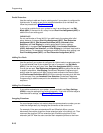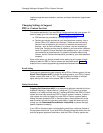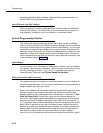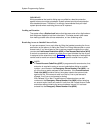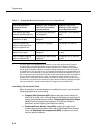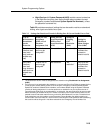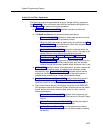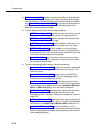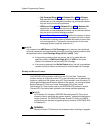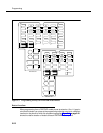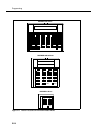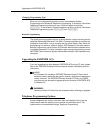
Programming
2-18
■ AA Extensions (#607) identifies an extension to which an auto attendant
is connected. This lets the system notify users with display phones when
they are receiving a call that has been transferred from the auto attendant.
Also, Transfer Return Extension (#306) lets you identify the extension to
which a call transferred by the auto attendant should be routed if the
destination extension does not answer.
■ The call reporting device uses the following procedures:
— SMDR Record Type (#608) specifies the type of calls that you want
to record for call reporting—either all calls or outgoing calls only.
— SMDR Top of Page (#609) notifies the system that the printer has
been aligned to the top of a new page.
— SMDR Output Format (#610) identifies whether a maximum of 15
digits or 24 digits is printed for dialed numbers on the call report.
— SMDR Talk Time (#611) specifies whether or not the call report
includes the Talk field, which records the time a user spends on an
incoming outside call—from the time the user answers the call to the
time the call is disconnected from the system.
— Account Code Entry lets users enter account codes for outside
telephone calls (incoming or outgoing); if used, the account codes
are included on the call report.
■ The voice messaging system uses the following procedures:
— Hunt Group Extensions (#505) assigns the extensions associated
with the voice messaging system hardware to Hunt Group 7—the
VMS Hunt Group.
— Group Call Distribution (#206) assigns lines to the VMS Hunt
Group so calls can ring directly into the voice messaging system
and receive Automated Attendant Service.
— Line Coverage Extension (#208) identifies an extension as the
owner of a specific outside line so calls on that line can ring directly
into the owner’s voice mailbox when either Automatic VMS Cover
(#310) or VMS Cover (F15) is on at the owner’s extension.
— VMS Hunt Delay (#506) determines when outside calls should be
answered by the Automated Attendant Service of the voice
messaging system. The system allows you to assign the number of
rings (0-6).
— VMS Hunt Schedule (#507) determines when outside calls should
ring the VMS Hunt Group (always, day only, or night only) depending
on the status of the Night Service Button (#503) at extension 10.
— Automatic VMS Cover (#310) determines whether or not an
extension’s unanswered intercom and transferred calls and outside
calls on lines assigned ownership are automatically covered by the
voice messaging system.



